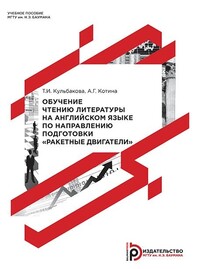Обучение чтению литературы на английском языке по направлению подготовки «Ракетные двигатели»
Покупка
Тематика:
Английский язык
Год издания: 2016
Кол-во страниц: 40
Дополнительно
Вид издания:
Учебное пособие
Уровень образования:
ВО - Специалитет
ISBN: 978-5-7038-4379-6
Артикул: 840477.01.99
Издание включает три модульных блока и три дополнительных текста. Каждый блок содержит по три текста из англоязычной научно-технической литературы, словарь с активной лексикой по изучаемой теме, лексико-грамматические упражнения, направленные на развитие и закрепление навыков понимания и перевода оригинальных текстов, а также умения устного общения на профессиональные темы.
Для студентов старших курсов, обучающихся по направлению подготовки «Ракетные двигатели».
Тематика:
ББК:
УДК:
- 6297: Авиация и космонавтика. Летательные аппараты. Ракетная техника. Космическая техника
- 811111: Английский язык
ОКСО:
- ВО - Специалитет
- 24.05.02: Проектирование авиационных и ракетных двигателей
ГРНТИ:
Скопировать запись
Фрагмент текстового слоя документа размещен для индексирующих роботов
Московский государственный технический университет имени Н.Э. Баумана Т.И. Кульбакова, А.Г. Котина Обучение чтению литературы на английском языке по направлению подготовки «Ракетные двигатели» Учебное пособие
УДК 802.0 ББК 81.2 Англ.-923 К90 Издание доступно в электронном виде на портале ebooks.bmstu.ru по адресу: http://ebooks.bmstu.ru/catalog107/book1410.html Факультет «Лингвистика» Кафедра «Английский язык для машиностроительных специальностей» Рекомендовано Редакционно-издательским советом МГТУ им. Н.Э. Баумана в качестве учебного пособия Кульбакова, Т. И. Обучение чтению литературы на английском языке по направлению подготовки «Ракетные двигатели» : учебное пособие / Т. И. Кульбакова, А. Г. Котина. — Москва : Издательство МГТУ им. Н. Э. Баумана, 2016. — 39, [1] с. : ил. ISBN 978-5-7038-4379-6 Издание включает три модульных блока и три дополнительных текста. Каждый блок содержит по три текста из англоязычной научно-технической литературы, словарь с активной лексикой по изучаемой теме, лексикограмматические упражнения, направленные на развитие и закрепление навыков понимания и перевода оригинальных текстов, а также умения устного общения на профессиональные темы. Для студентов старших курсов, обучающихся по направлению подготовки «Ракетные двигатели». УДК 802.0 ББК 81.2 Англ.-923 МГТУ им. Н.Э. Баумана, 2016 Оформление. Издательство ISBN 978-5-7038-4379-6 МГТУ им. Н.Э. Баумана, 2016 К90
ПРЕДИСЛОВИЕ Учебное пособие подготовлено в соответствии с учебными программами МГТУ им. Н.Э. Баумана. Оно предназначено для аудиторных занятий студентов старших курсов факультета «Энергомашиностроение» при обучении чтению и устной речи на английском языке под руководством преподавателя. Материал издания также может быть использован студентами для самостоятельной работы. Пособие состоит из трех модульных блоков и трех дополнительных текстов. В каждый блок включены оригинальные тексты из англоязычной научно-технической литературы, разнообразные лексико-грамматические упражнения, направленные на отработку языковых конструкций, которые характерны для научнотехнической литературы, а также упражнения на развитие коммуникативных навыков и словари, содержащие активную лексику и специальную терминологию по изучаемой в техническом вузе специальности. Задания, направленные на развитие устной речи, помогут студентам подготовить презентации, выступить с сообщениями, принять участие в обсуждениях.
UNIT 1 1. Read and learn the following words and word combinations: configuration — структура, конструкция, расположение, компоновка nozzle — сопло, форсунка propellant — ракетное топливо thrust — тяга, сила тяги mass flow rate — удельный массовый расход, массовая ско рость потока mass ratio — отношение масс, относительный массовый расход (в потоке) degradation — старение материала, ухудшение качества поверхности turbine — турбина throat — горловина, соединительная часть evaporation — испарение cryogenics — физика низких температур, криогенная техника hypergolic propellant — самовоспламеняющееся топливо swirl injector — вихревая форсунка orifice — отверстие plumbing — система труб coaxial injector — форсунка с коаксиальным впрыском annular aperture — кольцевая апертура, диафрагма cross section — поперечное сечение igniter — воспламенитель motive power — движущая сила 2. Give synonyms to the words below. Restriction, plumbing, issue, contraction, pipeline, problem, ensure, fulfil, enable, guarantee, implement, allow. 3. Translate the following word combinations into Russian. Majority of large liquid propellant engine systems, important consideration, fluid flow laws, combustion chamber design, low specific


